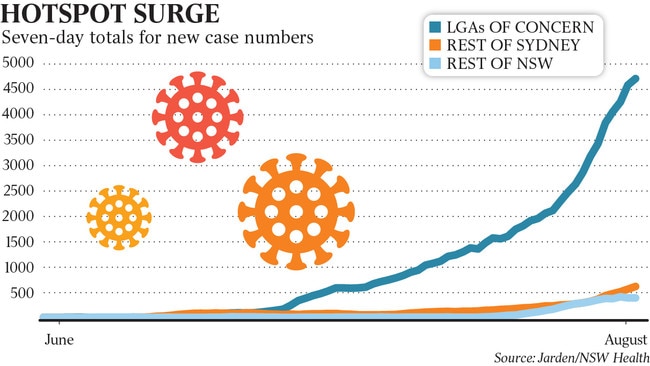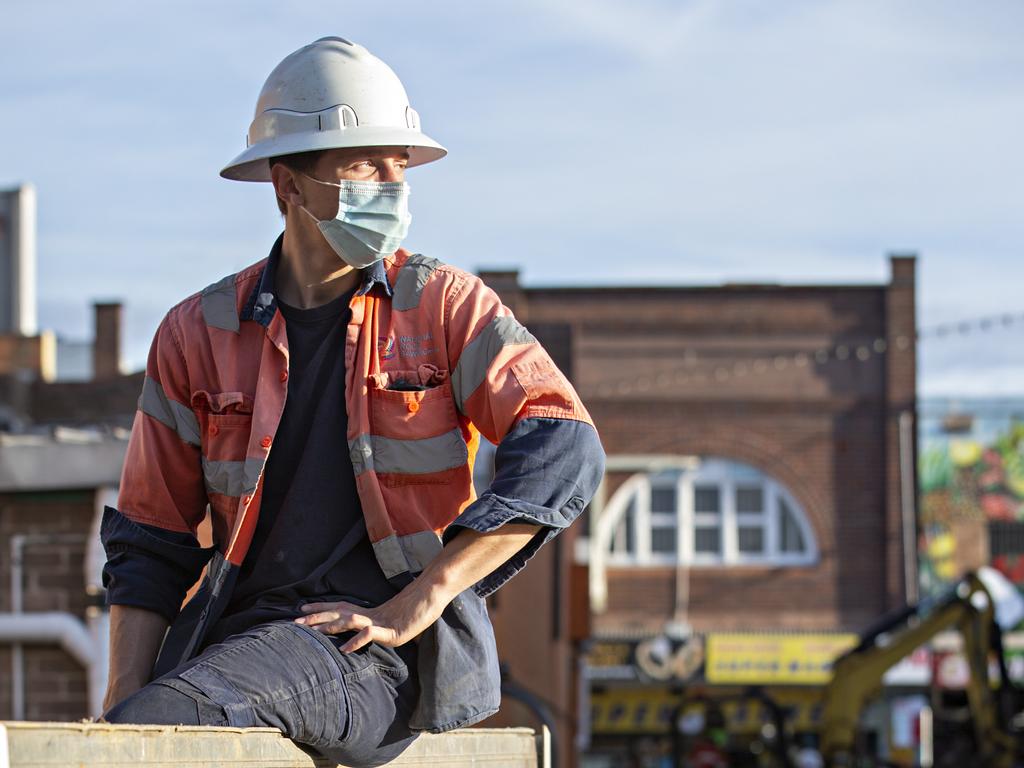Are essential workers or bad behaviour driving record infection rates in Western Sydney?
As NSW case numbers surge, and record vaccination rates follow, our largest state is preparing to ease restrictions.

As the daily number of new Covid-19 infections in NSW pushed through the attention-grabbing 1000 mark on Thursday, Gladys Berejiklian called on NSW businesses to “get ready” for reopening and even announced “baby steps” to freedom for inoculated citizens.
For many Australians, that was a whiplash moment: a record number of cases, most of them mystery infections, and yet “treats” in store as daily vaccinations hit a high of 143,000 in NSW and 335,000 around the country.
It’s kind of consistent and then it’s not, a pattern of mixed messaging in NSW during the prolonged lockdown that began in Greater Sydney on June 26.
Take the narrative about the spread of infection.
Berejiklian, Health Minister Brad Hazzard and chief health officer Kerry Chant have built an origin story on rising Covid-19 case numbers, despite the strict lockdown, which now includes a 9pm-5am curfew in 12 local government areas of concern.
One day, we’re told essential workers who live in designated hotspots and who must travel are transmitting the virus; the next, it’s people in western and southwestern Sydney doing the wrong thing, moving from house to house for socialising.
Both versions can be true, of course. An authorised worker may have been infected at work and then taken the virus home and infected the entire household. Then someone in that home does the wrong thing by visiting others.
But The Weekend Australian can reveal only 354 locally acquired cases of Covid-19 are due to direct workplace transmission from July 18, when further lockdown measures were implemented, to Monday evening. During that period there were 12,500 locally acquired new cases in NSW.
According to NSW health officials, transmission within the home accounts for 70 per cent of new infections, with transmission from those visiting other people’s homes the next-largest category.
Ten days ago, Chant told reporters workers in disability care, aged care, and those working in factories and cleaning “were going into workplaces, leading to transmission. And then transmission occurs, and then a seeding of another household”.

Chant added: “We also know that some people, a small proportion of people, are not perhaps taking Covid as seriously as I would like them to. And then what’s happening is they’re potentially going into multiple households, but in each of those households, you have got tens of people. And we know that household transmission for Covid is so common.”
Not only are those living in hotspots generally poorer and more ethnically diverse than the rest of Sydney, they’re in jobs that can’t be done at home, says Phillip O’Neill, an economic geographer from Western Sydney University. The vast region has also been the epicentre for recent job losses.
“These two million people are the core labour supply for Sydney,” says O’Neill, director of the Centre for Western Sydney at WSU. “Women predominantly work in government-funded healthcare and social services, while men are employed in construction, transport and wholesaling, and invariably that means driving all around the place.”
Close-contact workers in caring roles have been the main source of virus transmission, rather than construction workers, truck drivers or supermarket staff.
According to business groups, there have been infection outbreaks at food producers, logistics and transport providers, supermarkets and fast-food outlets.
But we just don’t know, given the high number of mystery cases, especially in the dozen hotspots. As Jarden chief economist Carlos Cacho noted, while NSW contact tracers “have generally performed very well through the pandemic, it appears that the current high caseload has overwhelmed the capacity”, which is not surprising given the exponential growth of a pandemic versus the linear grow of contact tracing capacity.
“Indeed, the current data on cases by transmission source potentially suggesting that 100-200 daily cases is about the effective limit of optimal contact tracing,” Cacho said.
Of current active cases in the state, 80 per cent are in LGAs of concern. The seven-day number of new local infections in these areas is now over 4700, compared with 618 in the rest of Sydney and 394 in the rest of NSW.
A NSW Health spokesman said other than the approximately 354 cases of workplace transmission identified in that five-week period “many remain under investigation and public health teams continue to process data related to cases”.
“Given this emerging information, it is expected there will be additional direct workplace transmission events identified,” the spokesman said.
“Workplaces are key settings where people are exposed to others outside their households, often for prolonged periods, and can potentially transmit Covid-19, which then gets passed onto others in their household and the general community.”
Chant says she wants “to see fewer people in settings where there are other people”, citing workplaces, childcare centres, and schools.
There have been 16,700 new locally acquired cases in NSW since the Bondi outbreak 10 weeks ago.
With one-third of citizens fully vaccinated, Berejiklian wants to begin a conversation with industry about how to reopen the NSW economy once the 70 per cent vaccination threshold in the national plan is reached, perhaps by mid-October in her state.
From Monday, authorised workers from the 12 LGAs who leave their areas for work will have to have received at least one vaccine dose or pass a rapid antigen test at their workplaces, a requirement small enterprises in retail, hospitality, manufacturing, administrative and financial services will struggle to meet.
The NSW Premier argues a combination of carrots and sticks will encourage vaccinations, especially in hotspots that even a month ago had very low take-up.
Residents of western Sydney have turned up in huge numbers for a jab. According to the federal Health Department, one-quarter of eligible residents of the mammoth Blacktown LGA, home to 400,000 people, have received a first dose in the past three weeks.
First-dose coverage in Blacktown, which has a high Indigenous population, rose from 39.7 per cent at the start of the month to 64.8 per cent; in Sydney’s inner southwest, southwest and outer southwest, where case numbers are highest, first-shot vaccination rates have jumped by more than 20 percentage points this month, and all three sub-state regions are above the national average.
Officials hope opening up vaccinations to 16-39-year-olds and essential workers will “break the transmission chain” and see case numbers tumble in coming weeks.







